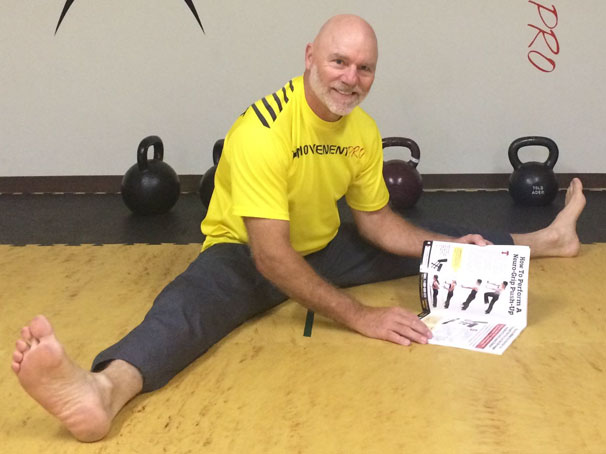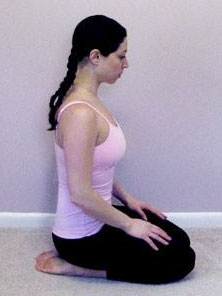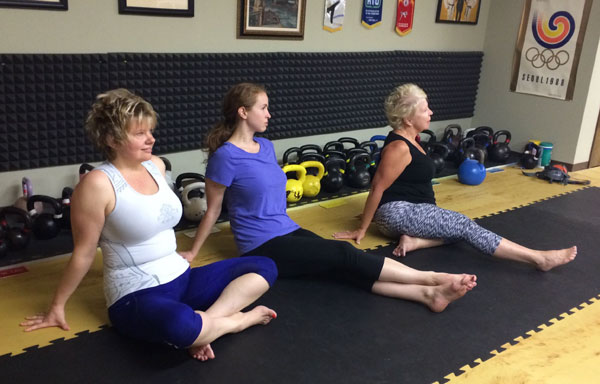
We have all heard about the bad things that happen to our bodies as a result of sitting in a chair—slumped shoulders, collapsed ribcages, tight hip flexors, weak abs, etc. Yet, if you want to improve your flexibility, I recommend you sit down. However, instead of sitting on your soft, comfy couch with a tv remote in one hand, your assignment is to sit on the floor.
The typical armchair encourages you to pour yourself into the seat, completely disengaging your glutes and abs. Then, a pair of armrests beg you to round your shoulders forward and flare your elbows outward—all while collapsing your ribcage. With your ribcage collapsed, your breathing will be compromised. In this position, your head will jut in front of your shoulders, and stress will begin to creep into your neck.
Nothing about the “armchair seated position” resembles quality postural alignment.
Prior to the invention of these cushy posture-destroying chairs, human beings were forced to sit differently. If, after miles of walking, you decided to rest on the side of the trail, you probably would have looked to rest your buns on a rock. In this position, you still need to maintain control to keep from falling off the rock. You’ll probably need to sit with a relatively erect posture, while keeping your head over your shoulders. After all, you are simply resting your legs and not your entire body. The only time you are supposed to be completely relaxed is while lying down.
 In our convenient Western lifestyle, we tend to stay further and further away from the ground. We don’t lie down or sit on the ground. However, sitting on the ground will potentially improve your flexibility for many other movements. I’ve outlined several ways to sit which can help improve posture, flexibility, and overall fitness.
In our convenient Western lifestyle, we tend to stay further and further away from the ground. We don’t lie down or sit on the ground. However, sitting on the ground will potentially improve your flexibility for many other movements. I’ve outlined several ways to sit which can help improve posture, flexibility, and overall fitness.
Sitting Cross-Legged
When we sit in the cross-legged position, the femurs of upper legs are moved into external rotation. Sitting this way may also automatically encourage you to open your chest and properly align your spine.
 Sitting on Your Heels
Sitting on Your Heels
When we sit on our heels, we’re obviously putting our knees into maximum flexion. Simultaneously, our feet will usually move into complete plantar flexion. Once again this position automatically encourages us to sit with an erect posture, activating the muscles which stabilize the spine.
Sitting with Internal Leg Rotation
Most people have a tough time moving their upper legs into significant internal rotation. However, if you can flex your knees, move your knees apart and sit between them, you will greatly improve your ability to internally rotate your hip joints. The little guy in the picture has a rather extreme range of motion and may actually prefer to sit in this position.

Sitting with Your Arms Behind You
The soft, cushy armchair combined with computer work constantly places our shoulders in front of our chest or sternum—encouraging internal rotation of the shoulder joint. When we sit on the floor and place one or both arms behind us, we externally rotate the upper arm and open the chest. This is an excellent corrective position.

Sitting with One or Both Legs Straight
If you want to improve your hamstring flexibility, or desire to do the splits, sitting with one or both legs straight is the ticket. Any method of sitting with one or both legs straight (see photo at the beginning of this post) will provide at least a little stretching of the straight leg. So, “stretching” doesn’t need to be just an activity within your kettlebell workout. You can just sit on the floor while working or watching television. More time spent in these positions will make them feel more natural. If you watch television—and I encourage you to find something else to do with your valuable time—start by sitting on the floor from one commercial break to the next. While you’re seated on the floor, increase your awareness of the position of your ribcage, head, and spine. You may be surprised by the intensity of the stretching sensations you feel from just spending time close to the earth.
***
Jay Armstrong is a Senior RKC, 6 Degree Black Belt TKD, and Master Z-Health Trainer. The past 30 years have been dedicated to helping others develop confidence through increased strength and pain-free, exceptional mobility. His quest for knowledge continues. He runs The Kettlebell Club in Houston, Texas.